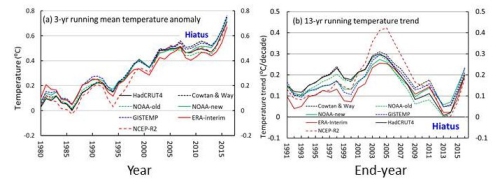Scientists Identify the Mechanism for Global Warming Slowdown in the Early 2000s
Date:2018-11-12
Global warming has been attributed to persistent increases in atmospheric greenhouse gasses (GHGs), especially in CO2, since 1870, the beginning of the Industrial Revolution. Nevertheless, the upward trend in global mean surface temperature (GMST) slowed or even paused during the first decade of the twenty-first century, even though CO2 levels continued to rise and reached nearly 400 ppm in 2013. This episode has typically been termed the global warming hiatus or slowdown in warming. The hiatus is characterized as a near-zero trend over a period. Detection found that the hiatus appeared during 2001-2013/2002-2012 with extremely weak interannual variability in some GMST sequences, and the slowdown in the others.

Fig.1 3-year running means (a) and 13-year running trends (b) for seven well-known global mean surface temperature sequences. (Image by DAI Xingang)
The hiatus is often attributed to internal climate variability, external forcing, or both, involving an increase in aerosols in the stratosphere during the period 2000-2010, the negative phase of the Interdecadal Pacific Oscillation (IPO) accompanying intensified trade winds, extensive heat uptake by the deep ocean or an extremely low number of sunspots during the latest solar activity cycle.
A new study by Institute of Atmospheric Physics at Chinese Academy of Sciences reveals that the global warming has never stopped in the past hundred years, with maximum rate of change after Second World War II and almost constant rate (0.08oC/10a) during the latest three decades. However, the key cooling against global warming comes from the interannual variability of the temperature that is coincided with the variability of the sea surface temperature in the equatorial mid-eastern Pacific. Hence, the hiatus is merely a decadal balance between global warming and the cooling resulting from anomalous sea surface temperature in equatorial Pacific.
The hiatus ended in 2014 as a new El Nino Southern Oscillation (ENSO) event was developing in the equatorial mid-eastern Pacific which caused a rapid warming in the earth. On the other hand, the multidecadal climate oscillation follows a downward path with increase in cooling.
"Our study suggests that future climate conditions will likely rely on competition between multidecadal cooling and global warming if the multidecadal climate cycle repeats, as was experienced during the second half of the twentieth century.” Says Dr. DAI Xingang, the lead author of the paper.
